|
1989 - Aerobatics, Biscuits and Buildings
By this time United Biscuits Group had grown to encompass companies throughout Europe, so the requirement for the aviation department had grown with it. To ensure operations could continue in all weather at Denham the company requested the installation of a hard taxiway between the blister hangar, where they kept their aeroplane, and the runway. This would mean that even if the flooding of previous years was repeated their aeroplane would not be grounded. The construction of the taxiway was based on a Second World War idea of laying steel mesh the grass. This also had the advantage of being practically invisible, not detracting from the appearance of the aerodrome. This taxiway was in place in time for the annual board meeting of the company, where so many executives had to be transported from all over Europe that a second Beechcraft King Air had to be chartered to cope with the numbers.
|
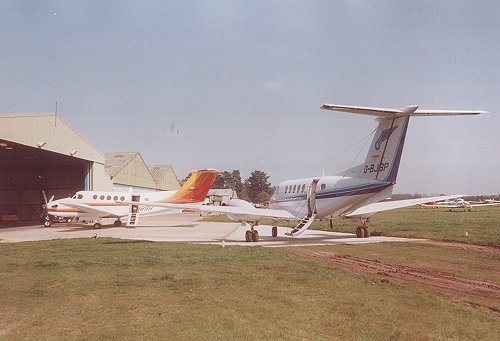
United Biscuits required the use of another King Air for their annual board meeting in 1989, the chartered aircraft is seen here with one of their fleet. The hardened taxiway track can just be made out behind the aircraft.
|
Aside from their fleet of King Air turboprops, United Biscuits also became the first operator to bring a commercial jet aeroplane into Denham, experimenting with a Cessna Citation business jet during 1989. This year was also to see the retirement of Sir Hector Laing as the group's chairman. A remarkable man and a great aviation enthusiast, he saw the advantages of business aircraft and developed the aviation department to serve the needs of the rapidly growing company. During his tenure as chairman, the group had seen its profits increase from £8 million to over £200 million, a testimony to his effectiveness and leadership.
| 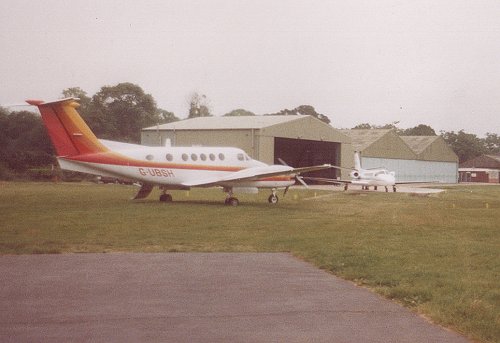
United Biscuits also brought the first commercial jet aeroplane to Denham in the shape of this Cessna Citation during 1989.
|
It was not just corporate aviation that enjoyed a boost at Denham during 1989. Aerobatic pilot Brian Lecomber had been successful in attracting sponsorship for his growing fleet of aircraft. The Extra 230 was still proudly resplendent in the colours of Jaguar cars, while his two seat Pitts S2B was now in the markings of computer and IT leasing and support company Microlease, the beginings of an association that was to last nearly two decades. The Pitts was not only used to perform at displays around the country, but was also used to fly the company's guests to give them a taste of aerobatic flying. This proved to be an excellent marketing tool for the company as their brand was firmly imprinted on the minds of their customers after such a remarkable experience.
|

Brian Lecomber added this Pitts S2B two seater to his stable, sponsored by Microlease in an association that was to last nearly two decades.
|
As well as his success in attracting sponsors and in performing at displays all over the UK and Europe, Brian had also been successful in aerobatic competitions, becoming the UK's Freestyle Champion in 1989. In this success he was joined by his friend John Harper, who was runner up in the UK Aerobatic Championship that year. Known as Harpo to one and all, the affable and popular John was a familiar face at Denham, having been part of the aerobatic and display world for many years.
In order to practice low level aerobatics the pilots required permission from the Civil Aviation Authority. They also needed an aerodrome so they could orientate their manoeuvres along the runway. Whilst some neighbours loved to watch the free air displays, each performance was kept to less than five minutes, partly because the pilots physically could not stand longer and partly because some local residents objected. The aerodrome management endured much opposition and abuse for allowing this to take place.
|
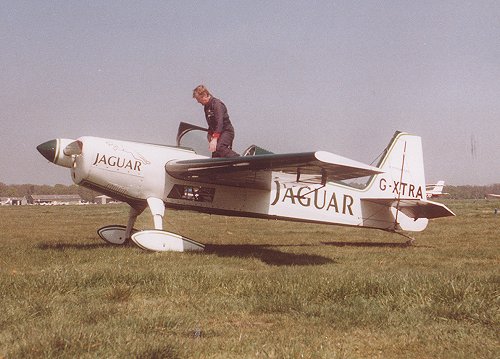
Brian Lecomber in his Extra 230, the aircraft he won the UK Freestyle Championship in 1989.
|
|

John Harper was runner up in the UK Aerobatic Championship and was often seen at Denham, particularly flying Brian Lecomber's Stampe SV4C, an aircraft he bought in 1978 and was not to part with until 2000.
|
Alongside the flying schools, helicopters and private aircraft, the aerodrome was home to some unusual types of aerobatic and vintage aircraft during this time, both resident and as visitors. Below are a selection of the types that could be found at Denham in 1989.
|
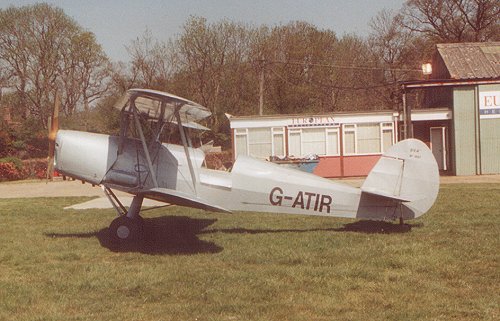
This Stampe SV4C was owned by Clive Watson at the beginning of the year, but was purchased by local aviation author and jounalist Nick Bloom, who was to operate it from his farm strip nearby for the next twelve years.
|
|
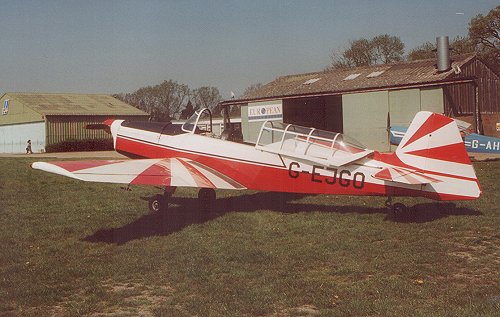
One of the great competition and aerobatic training aircraft of the 1960s and 1970s, this Zlin Z.226T was bought by Nick Radford in 1985 and remained at Denham until 1997.
|
At various times Richard James Parker had collected many of the past British training aeroplanes some of which spent time at Denham. He had each one thoroughly overhauled to pristine condition. They included an Auster J1N, G-AHSS, a Tiger Moth, a Boeing A75N1 Stearman G-AZLE, Chipmunk G-AOFE, Noorduyn built Harvard IIB G-BAFM and, pride of place, Spitfire Mk IXT G-TRIX.
In early 1945 this Spitfire LF Mk IX was issued to 412 Squadron of the Royal Canadian Air Force, flying from Heesch in the Netherlands with the codes ‘VZ-M' and ‘VZ-W', flying 76 sorties before the war's end.
After the war PV202, to give the Spitfire its military registration, was converted to a two-seat trainer by Vickers Armstrong for service with the Irish Air Corps. After many years in storage with various owners, in 1980 Steve Atkins began a restoration resulting in the Spitfire flying again on 23 February 1990, Richard Parker having bought the aircraft in 1988 while it was being rebuilt. The Spitfire had been painted as VZ-M of 412 Canadian Squadron and Richard tracked down one of the Canadian pilots who had flown the aircraft during war. Richard brought him over the pond to fly in it once again and he put on a garden party at Denham to show it off. The unmistakeable sound of its Packard built Rolls Royce Merlin 266 engine was a thrill. Only six neighbours complained about the Spitfire, and on this one occasion only, their complaints were ignored. The aircraft was owned and operated by a number of people after Richard sold his fleet in 1992, we are delighted to know that it is still flying at Duxford.
|
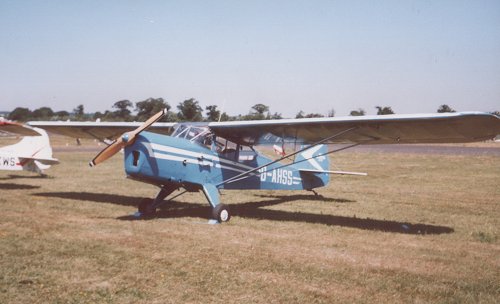
Richard Parker's first classic trainer aircraft was Auster J1N G-AHSS, purchased on 2 August 1982.
|
|
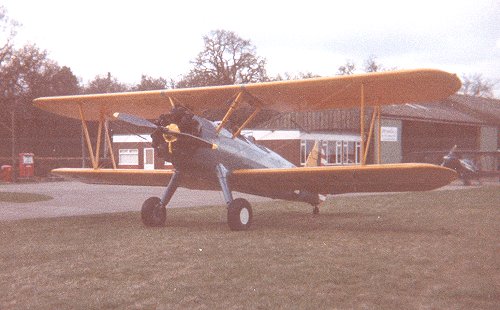
Richard Parker's next purchase was the famous American trainer, the Boeing A75N1 Stearman biplane. This aircraft, G-AZLE, was bought on 15 April 1987.
|
|
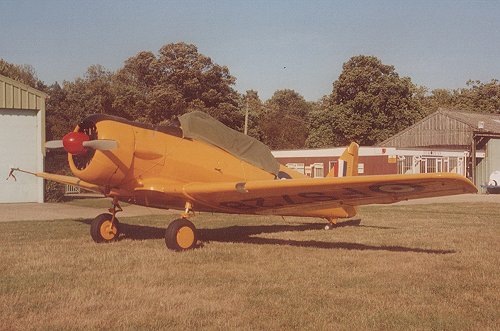
Richard Parker purchased this Noorduyn built North American T.6 Harvard IIB in 1986, one of the great training aircraft in aviation history.
|
|
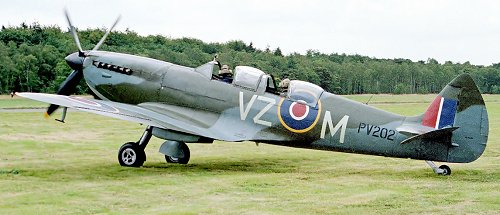
Richard Parker purchased Spitfire Mk IXT G-TRIX during its restoration to fly in 1988 and flew it from 1990 to 1992.
|
|
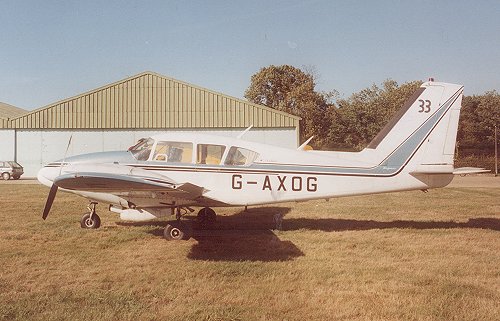
Typical of the private pilots in 1989, Northwood based Ron Diggens kept his Piper PA23 Aztec at Denham until 1997.
|
| 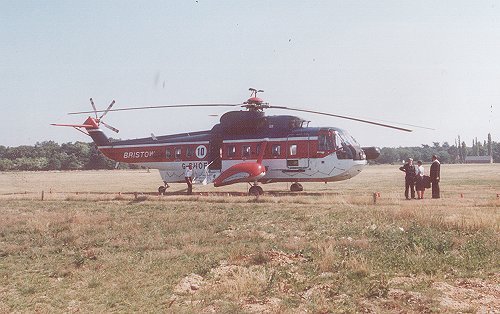
There are regular events that bring unusual visiting aircraft to Denham. One of these is the Silverstone helicopter shuttle taking passengers to the Formula One race. Bristows used several Sikorsky S-61s in 1989.
|
| 
One highly unusual visitor was this Astir glider, seen here outside Biggles restaurant. The pilot elected to land at Denham rather than be driven into the London Control Zone by the weather.
|
On 5 July, the Slingsby T.67 Firefly belonging to the BBC Flying Club was taking off to fly to Cranfield with Duncan Thomas and Robert Stockholm on board. During the take off the aircraft rolled to the left and the port wing struck the ground, causing the aircraft to roll over and end up upside down on the grass next to the runway. Both occupants quickly evacuated the aircraft suffering only minor injuries. The aircraft was largely made of fibreglass, which had the advantage of being lighter than aluminium. But when it caught fire, despite the best efforts of the fire crew, it completely burnt out except for the port tailplane.
|
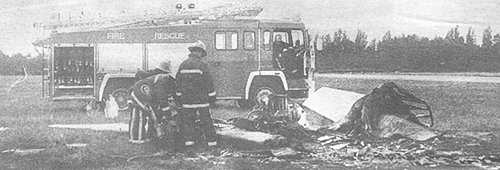
The remains of the BBC Flying Club's Slingsby T.67 Firefly being examined by the local fire brigade.
|
The very popular Biggles restaurant had started in a building dating back to the 1930s, formerly a private house and later a flying club, so it was not surprising that it needed some repairs. The outer wall of the bathroom over the front door and hall was rebuilt with modern insulation. The kitchen required extra storage space and this was provided by adding a small building behind the garage. Finally, the large and unsightly ventilation chimney was removed and redirected.
|
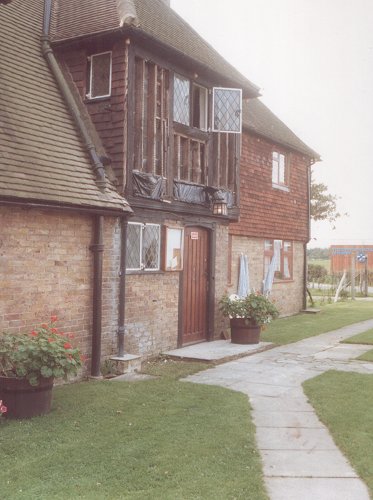
The insulation and boarding around the front door was replaced and upgraded in 1989.
|
|
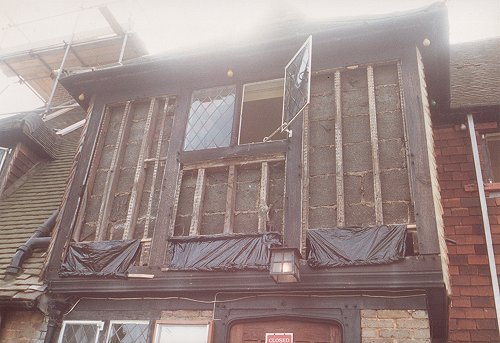
The front wall of Biggles' was stripped.
|
|
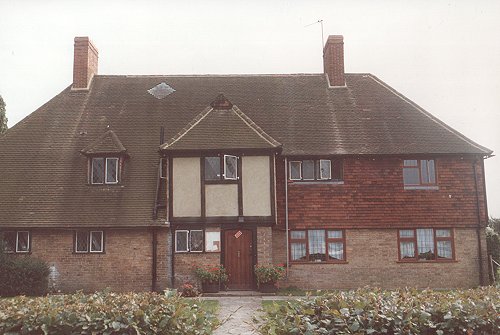
Biggles' restaurant with the new cladding in place.
|
|
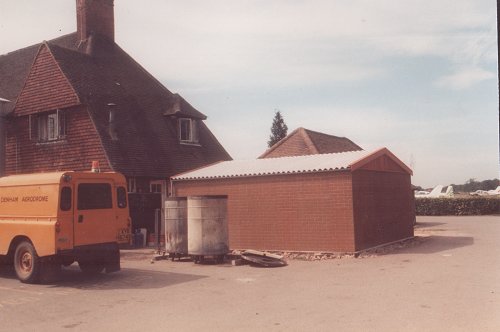
A new store room was added for use by the restaurant.
|
|
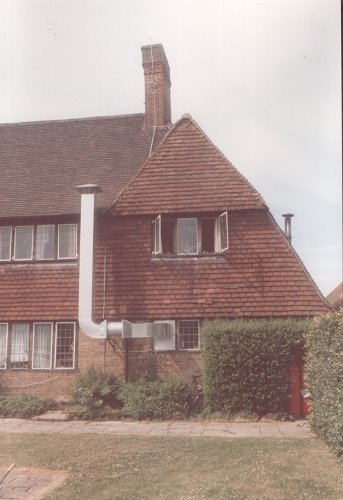
The large and unsightly ventilation chimney was removed and replaced.
|
The range of facilities and services offered by European Helicopters was expanded by the addition of a paint shop "spray bake" into the end of hangar J. This meant that helicopters could be stripped and fully repainted using modern synthetic paints which required a heat treatment to seal them. At the time this made Denham one of only three places in the UK that could offer such services.
|
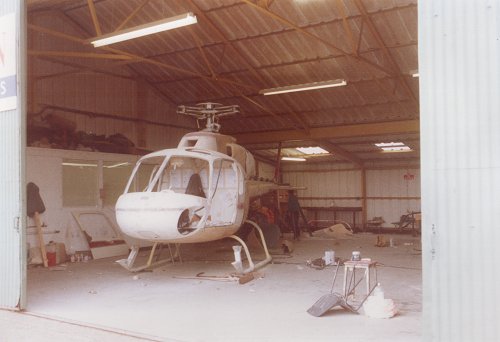
The spray bake paint facility in the end of Hangar J with a Squirrel helicopter being repainted.
|
European Helicopters were proving to be a very successful company by 1989. Given the range of aircraft they were now supporting, including large helicopters like the London Air Ambulance Aerospatiale AS.155 Dauphin, it quickly became apparrent that more space would be needed to service these machines. A prolonged battle over the planning permission enused. Not satisfied with an Appeal for the original hangar, nothing less than at Public Enquiry was required to obtain permission to extend the front of Hangar I by 25 feet (8 meters). This was eventually granted in early 1989. Work began in September with the front and doors being removed and a plastic sheet put in place to protect the inside.
|
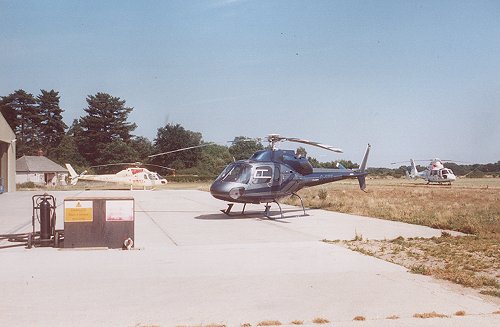
European Helicopters was very successful by 1989, with regular customers such as the London Air Ambulance seen here with two Squirrel types. The company needed more space to maintain these complex aircraft.
|
|
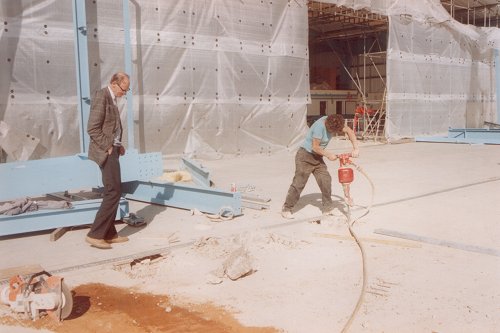
Ian Paul watches as the foundation holes for the new structure are drilled. The temporary front wall can be seen behind.
|
|
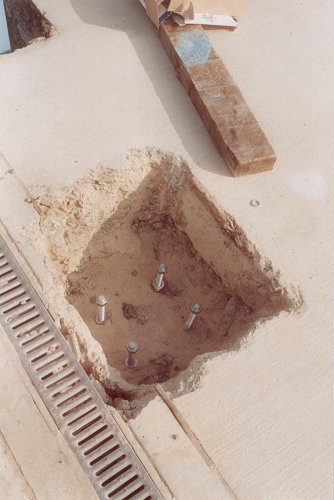
The foundation blocks had inset bolts to allow the structure to be attached.
|
|
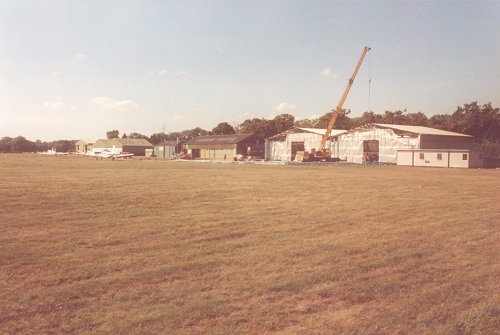
An unusual view along the front of the hangars in 1989, with the Hangar I extension beginning construction.
|
|
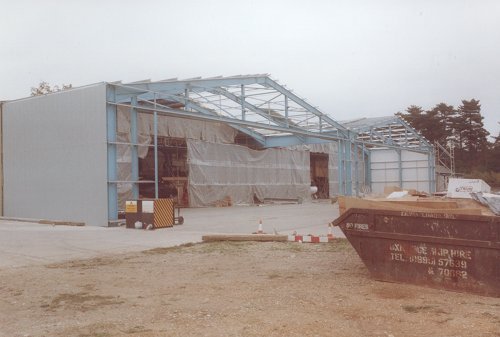
The extension structure nearly complete with the end walls in place.
|
One of the additions to the airfield equipment in 1989 was an American Jeep modified into a fire vehicle by the specialists, Carmichael. This was provided by a tenant for use by the aerodrome, but in practice proved too heavy for the largely grass surface and was withdrawn from service by 1993, being replaced by a Land Rover and later Toyota pick ups.
|
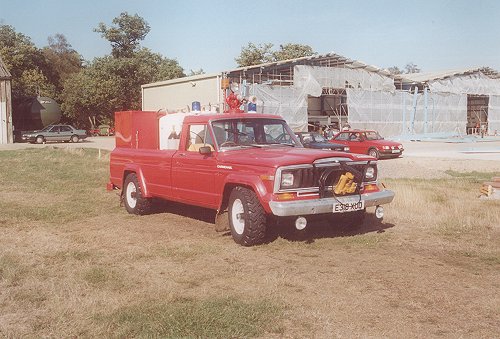
The Jeep fire vehicle, though well equipped, proved too heavy for the aerodrome.
|
Aside from maintaining helicopters, European Helicopters also traded and acted as brokers for a variety of types. In 1989 they purchased two Aerospatiale AS.340 Gazelles, both of which were sold within the year. One was to spend most of its time in the UK, the other being brought and sold as far afield as Belize. Oddly, both airframes were to be exported to Hungary eventually, one in 2004, the other in 2012.
|

These Gazelles were both bought and sold by European Helicopters in 1989, after varied careers both were exported to Hungary.
|
Another planning permission was applied for and granted regarding Hangar I during 1989. This was to allow the construction of flight planning offices next to the hangar to allow pilots an area to study meteorology and other factors affecting their flights and to make their plans accordingly. In the event, this was never built, and the north side office building continued in this role into the 1990s.
|
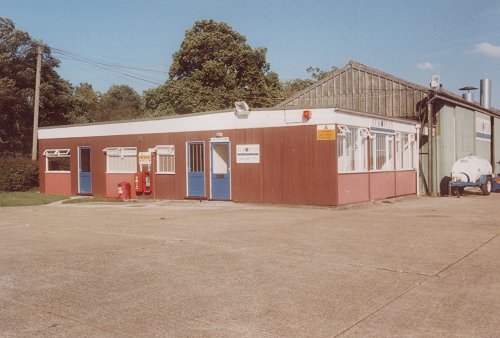
The north side offices now served European Helicopters in a variety of roles.
|
The year had seen a lot of building and other tasks completed on the aerodrome, with a notable first in terms of the first civilian jet aircraft to land at the aerodrome. Denham was well set to enter into the new decade, as will be related next.
|
|

